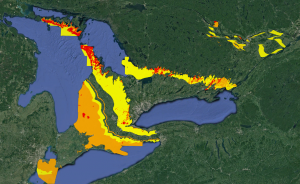Karst
Karst formations are found in areas along the Niagara Escarpment, including the Bruce Peninsula, the Guelph/Rockwood/Elora area of Wellington County and in portions of eastern Ontario[1].
Karst formations, in which there are undetected sinkholes, trenches and caverns, can be dangerous[edit]
There is no one formula for defining a hazardous area associated with karst formations. Defining the “area of provincial interest” is a site-specific process. The size, extent and severity of the hazards depend on local conditions[2]. Karst formation character and size depends on the pH of the infiltrating water, the rate at which the rock dissolves, number of fractures and fissures in the rock, distance the water will percolate from surface to water table and the presence of impermeable layers above or below the limestone/dolomite layers.
Karst formations can also be significant recharge zones for municipal supply aquifers[edit]
For example, the City of Guelph, whose drinking water supply is wholly groundwater, is known to be a direct recipient of significant recharge through the areas karst formations.
- ↑ Ontario Ministry of Northern Development and Mines. Karst. https://www.mndm.gov.on.ca/en/mines-and-minerals/applications/ogsearth/karst. Published 2017. Accessed October 17, 2017.
- ↑ Ontario Ministry of Natural Resources. Understanding Natural Hazards.; 2001. http://www.trentu.ca/iws/documents/GLSLRS_UnderstandingNaturalHazard_Intro.pdf. Accessed October 17, 2017.
